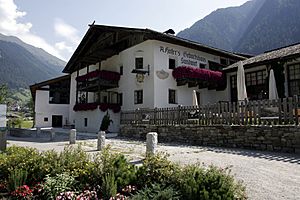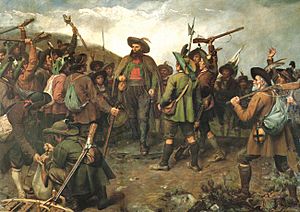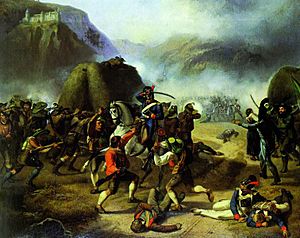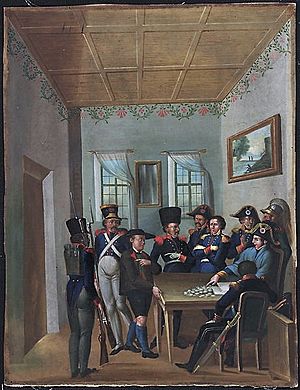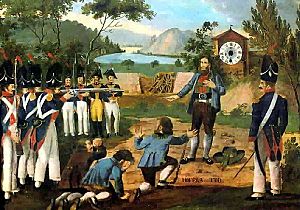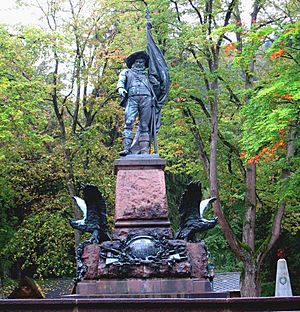Andreas Hofer facts for kids
Andreas Hofer (born November 22, 1767 – died February 20, 1810) was an innkeeper and animal trader from Tyrol. In 1809, he became the main leader of the Tyrolean Rebellion. This was a fight against the French army led by Napoleon and their allies, the Bavarians, during the War of the Fifth Coalition. Andreas Hofer was later captured and executed.
Today, many people still see Hofer as a folk hero, a brave fighter for freedom, and a true Austrian patriot. His great-grandson, also named Andreas Hofer, was an important member of a group that resisted Nazi Germany.
Contents
Life of Andreas Hofer
Andreas Hofer was born in 1767 in St. Leonhard in Passeier, a part of Tyrol that belonged to the Habsburg Empire. His father owned the Sandhof inn, and Andreas took over the business when his father died. He also bought and sold wine and horses in nearby Northern Italy, which helped him learn Italian. He married Anna Ladurner. In 1791, he was chosen to be part of the Tyrolean Landtag (a local assembly). People often called him Sandwirt, which means "innkeeper of the Sandhof."
During the War of the Third Coalition against France, Hofer joined the Austrian army as a sharpshooter and later became a militia captain. After Austria lost the war, Tyrol was given to the Kingdom of Bavaria (which was an ally of France) in 1805, as part of the Treaty of Pressburg. The Bavarian government, led by Minister Maximilian von Montgelas, made strict rules and forced young men to join the Bavarian Army. This made Hofer a key leader of the movement against Bavarian rule. In January 1809, he went to Vienna with others to ask Emperor Francis I of Austria for help with a possible uprising. The Emperor promised his support, and the group returned home.
Hofer began to secretly plan the rebellion. He visited villages and held secret meetings in local inns. He was always on the move, so he often signed his messages "Andreas Hofer, from where I am." Letters to him were addressed to "wherever he may be." Other leaders in the Alps also organized their own groups. Hofer became a leader of a militia group in the Passeier Valley.
The Rebellion Begins
The Tyrolean Rebellion started on April 9, 1809, in Innsbruck. The night before, organizers threw bags of sawdust into the Inn River. This was a secret signal to begin the rebellion. As the sawdust floated through the town and down the valley, it alerted the rebels. Church bells rang to call men to fight with their muskets and farm tools. They quickly took over smaller Bavarian army posts and surprised a group of French soldiers passing through the area.
On April 11, Tyrolean fighters defeated a Bavarian force in Sterzing. This led to them taking over Innsbruck before noon. Even though French troops came from the Brenner Pass to help, and a combined French-Bavarian force attacked the next night, the Tyroleans fought them in the First Battle of Bergisel. Hofer and his allies won on the morning of April 13. Austrian forces, led by General Johann Gabriel Chasteler de Courcelles, then moved into Innsbruck and set up a temporary government. Hofer moved south, capturing Bozen and Trent.
Hopes for a successful rebellion started to fade when Napoleon defeated the Austrian army in several battles, including Teugen-Hausen, Abensberg, Eckmühl, and Ratisbon. After these defeats, the Austrian troops left Tyrol, and Hofer had to retreat to the mountains. French Marshal François Joseph Lefebvre took control of the fight in Tyrol. Bavarian and Saxon forces, led by Karl Philipp von Wrede, defeated the Austrians in a fierce fight at Wörgl on May 13. The Bavarians re-occupied Innsbruck on May 19. However, when their French allies left, the rebellion started up again.
Hofer Takes Charge
Hofer became the main leader of the Tyrolean rebels. He had the support of other important leaders like Josef Speckbacher and Father Joachim Haspinger. He commanded about 20,000 Tyrolean fighters, plus a few hundred Austrian soldiers who had joined them.
In the second Battle of Bergisel, from May 25 to 29, 1809, Hofer's troops again defeated the Bavarians. They drove them out of the country and retook Innsbruck on May 30. On May 29, Hofer received a letter from Emperor Francis. The Emperor promised not to sign any peace treaty that would give up Tyrol. An Austrian official came to govern Tyrol, and Hofer returned to his home. However, Napoleon again defeated Austrian troops in the Battle of Wagram on July 6. The Armistice of Znaim then gave Tyrol back to Bavaria. Napoleon sent 40,000 French and Bavarian troops to take over Tyrol, and they re-occupied Innsbruck.
After a short pause, Hofer decided to fight again. The French offered a reward for his capture. On August 13–14, in the third Battle of Bergisel, Hofer's Tyroleans defeated the French troops of Marshal François Joseph Lefebvre. This was a 12-hour battle that ended with a charge down the hill. The Tyroleans once again retook Innsbruck.
Hofer declared himself the Imperial Commandant of Tyrol. He ruled the land from the Hofburg palace in the name of the Austrian Emperor for two months. He announced new laws and taxes and even made his own coins. He also sent two men to Britain to ask for help. On September 29, he received a medal from the Emperor and another promise that Austria would not abandon Tyrol.
Hofer's hopes were crushed on October 14, when the Treaty of Schönbrunn again gave Tyrol to Bavaria. French and Bavarian troops advanced, and Hofer retreated to the mountains. After being promised amnesty (forgiveness), Hofer and his followers put down their weapons on November 8. Hofer then went back to his home valley.
Final Attempt and Capture
On November 12, Hofer received false news about Austrian victories. He tried to gather his troops again on November 15. This time, very few people followed him, and French troops easily defeated his small force. His commanders surrendered and told him to escape over the mountains.
Hofer hid in a small hut in the mountains in the Passeiertal valley. The French announced a reward of 1500 guilders for his capture. His neighbor, Franz Raffl, betrayed him and told the authorities where he was hiding. Hofer was captured by Italian troops on January 28, 1810. He was sent in chains to Mantua to face a court-martial (a military trial). (Franz Raffl later died poor in Bavaria twenty years later.)
Trial and Execution
The officers holding the court martial disagreed on what sentence to give Hofer. Then, they received a message from Milan, supposedly from the Viceroy. It said that Napoleon ordered them to "give him a fair trial and then shoot him." Later, Napoleon told Prince Metternich that Hofer was executed against his wishes.
Andreas Hofer was executed by a firing squad on February 20, 1810. He refused to wear a blindfold or to kneel. He gave money to the corporal in charge, telling him to "shoot straight." He even gave the order to fire himself. Hofer became a martyr (someone who dies for a cause) in Germany and Austria. He became a symbol of resistance against Napoleon's power.
Legacy and Monuments
In 1809, the poet William Wordsworth wrote some sonnets about Andreas Hofer. These poems helped to create a romantic image of him and the story of the rebellion.
In 1818, Hofer's family was given a special honor by the emperor of Austria. (He and Anna had seven children, and at least two of them moved to America.) In 1823, Hofer's body was moved from Mantua to Innsbruck. In 1834, his tomb was decorated with a marble statue. In 1893, a bronze statue of Hofer was put up in Bergisel (Innsbruck). A large painting showing his arrest hangs in the Palace of Maria Theresa in Innsbruck. Every year, there is an open-air play in Meran based on his life. In Meran, there is also a large statue of him across from the train station, put up by Tyrolean nationalists in 1915. In New Glarus, Wisconsin, there is a big painting of Hofer inside Puempel's Olde Tavern.
The song Zu Mantua in Banden (which is now the official song of the State of Tyrol) tells the story of his sad fate and execution. His most famous quote is: I will not trade my life for a lie.
Literature
- Andreas Hofer is a historical novel by Luise Mühlbach, written in 1871.
- Hofer and his wife appear as small characters in the time travel novel Time for Patriots. The author of this book is a great-great-great-great-grandson of the Hofers.
Films
- Andreas Hofer (1929): starring Fritz Greiner as Andreas Hofer and Maly Delschaft as Anna Hofer, directed by Hans Prechtl.
- Der Rebell (1932): directed by Luis Trenker.
- Andreas Hofer – Die Freiheit des Adlers (2002): starring Tobias Moretti as Andreas Hofer and Franz Xaver Kroetz as Joachim Haspinger, directed by Xaver Schwarzenberger.
- The Holy Land of Tyrol (2010): starring Klaus Gurschler as Andreas Hofer and Verena Buratti as Anna Hofer, directed by Philipp J. Pamer.
See also
 In Spanish: Andreas Hofer para niños
In Spanish: Andreas Hofer para niños



